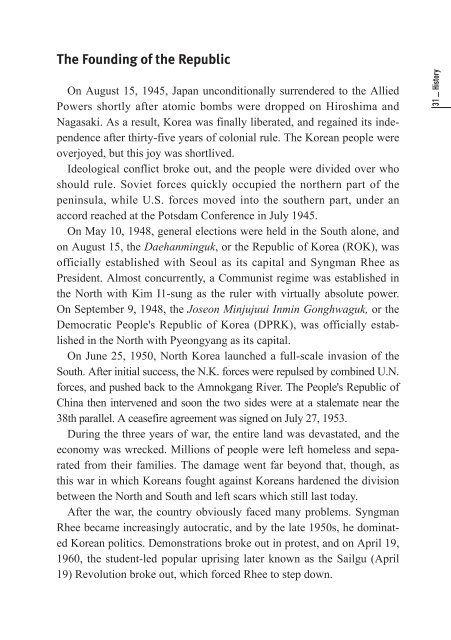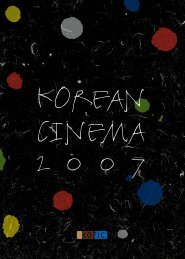HELLO from KOREA
Hello-Eng(3.3) - Korea.net
Hello-Eng(3.3) - Korea.net
- No tags were found...
Create successful ePaper yourself
Turn your PDF publications into a flip-book with our unique Google optimized e-Paper software.
The Founding of the Republic<br />
On August 15, 1945, Japan unconditionally surrendered to the Allied<br />
Powers shortly after atomic bombs were dropped on Hiroshima and<br />
Nagasaki. As a result, Korea was finally liberated, and regained its independence<br />
after thirty-five years of colonial rule. The Korean people were<br />
overjoyed, but this joy was shortlived.<br />
Ideological conflict broke out, and the people were divided over who<br />
should rule. Soviet forces quickly occupied the northern part of the<br />
peninsula, while U.S. forces moved into the southern part, under an<br />
accord reached at the Potsdam Conference in July 1945.<br />
On May 10, 1948, general elections were held in the South alone, and<br />
on August 15, the Daehanminguk, or the Republic of Korea (ROK), was<br />
officially established with Seoul as its capital and Syngman Rhee as<br />
President. Almost concurrently, a Communist regime was established in<br />
the North with Kim I1-sung as the ruler with virtually absolute power.<br />
On September 9, 1948, the Joseon Minjujuui Inmin Gonghwaguk, or the<br />
Democratic People's Republic of Korea (DPRK), was officially established<br />
in the North with Pyeongyang as its capital.<br />
On June 25, 1950, North Korea launched a full-scale invasion of the<br />
South. After initial success, the N.K. forces were repulsed by combined U.N.<br />
forces, and pushed back to the Amnokgang River. The People's Republic of<br />
China then intervened and soon the two sides were at a stalemate near the<br />
38th parallel. A ceasefire agreement was signed on July 27, 1953.<br />
During the three years of war, the entire land was devastated, and the<br />
economy was wrecked. Millions of people were left homeless and separated<br />
<strong>from</strong> their families. The damage went far beyond that, though, as<br />
this war in which Koreans fought against Koreans hardened the division<br />
between the North and South and left scars which still last today.<br />
After the war, the country obviously faced many problems. Syngman<br />
Rhee became increasingly autocratic, and by the late 1950s, he dominated<br />
Korean politics. Demonstrations broke out in protest, and on April 19,<br />
1960, the student-led popular uprising later known as the Sailgu (April<br />
19) Revolution broke out, which forced Rhee to step down.<br />
31 _ History
















